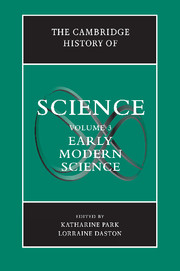Book contents
- Frontmatter
- 1 Introduction: The Age of the New
- Part I The New Nature
- Part II Personae and Sites of Natural Knowledge
- 6 The Man of Science
- 7 Women of Natural Knowledge
- 8 Markets, Piazzas, and Villages
- 9 Homes and Households
- 10 Libraries and Lecture Halls
- 11 Courts and Academies
- 12 Anatomy Theaters, Botanical Gardens, and Natural History Collections
- 13 Laboratories
- 14 Sites of Military Science and Technology
- 15 Coffeehouses and Print Shops
- 16 Networks of Travel, Correspondence, and Exchange
- Part III Dividing the Study of Nature
- Part IV Cultural Meanings of Natural Knowledge
- Index
- References
16 - Networks of Travel, Correspondence, and Exchange
from Part II - Personae and Sites of Natural Knowledge
Published online by Cambridge University Press: 28 March 2008
- Frontmatter
- 1 Introduction: The Age of the New
- Part I The New Nature
- Part II Personae and Sites of Natural Knowledge
- 6 The Man of Science
- 7 Women of Natural Knowledge
- 8 Markets, Piazzas, and Villages
- 9 Homes and Households
- 10 Libraries and Lecture Halls
- 11 Courts and Academies
- 12 Anatomy Theaters, Botanical Gardens, and Natural History Collections
- 13 Laboratories
- 14 Sites of Military Science and Technology
- 15 Coffeehouses and Print Shops
- 16 Networks of Travel, Correspondence, and Exchange
- Part III Dividing the Study of Nature
- Part IV Cultural Meanings of Natural Knowledge
- Index
- References
Summary
There can be little argument with the claim that early modern science and technology developed in large measure within a limited set of localized sites that ranged from state-supported scientific academies and observatories to botanical gardens, aristocratic collections, and apothecary shops. Nor can there be any question of the importance of local, face-to-face interactions in the creation of the “forms of life” that were characteristic of these social microenvironments. Yet it is equally true that local knowledge was very often embedded in geographically extended networks of communication and exchange. These multiple, often overlapping networks directly facilitated the gathering of information and natural objects as well as the dissemination of the natural knowledge produced at those sites. Indeed, between the fifteenth and eighteenth centuries, European knowledge of the natural world depended increasingly upon expert practitioners who were entrusted with providing reliable information and authentic natural specimens while traversing ever larger and ever more remote geographical tracts. Broadly stated, the early modern period witnessed unprecedented growth in the scale of scientific practice in regard to both the number of formally trained practitioners and the geographical range over which they traveled.
THE EXPANDING HORIZON OF SCIENTIFIC ENGAGEMENT
Although networks of travel and correspondence grew extensively during the late Middle Ages, they were almost without exception confined to the lands of Europe and the coasts of the Mediterranean Sea. Moreover, even within these geographical limits, networks of exchange lacked the density they were to achieve later. Transnational postal services connected only the major capitals and were primarily limited to the administrative and diplomatic correspondence of states (especially the Holy Roman Empire) and the papacy.
- Type
- Chapter
- Information
- The Cambridge History of Science , pp. 341 - 362Publisher: Cambridge University PressPrint publication year: 2006
References
- 15
- Cited by

